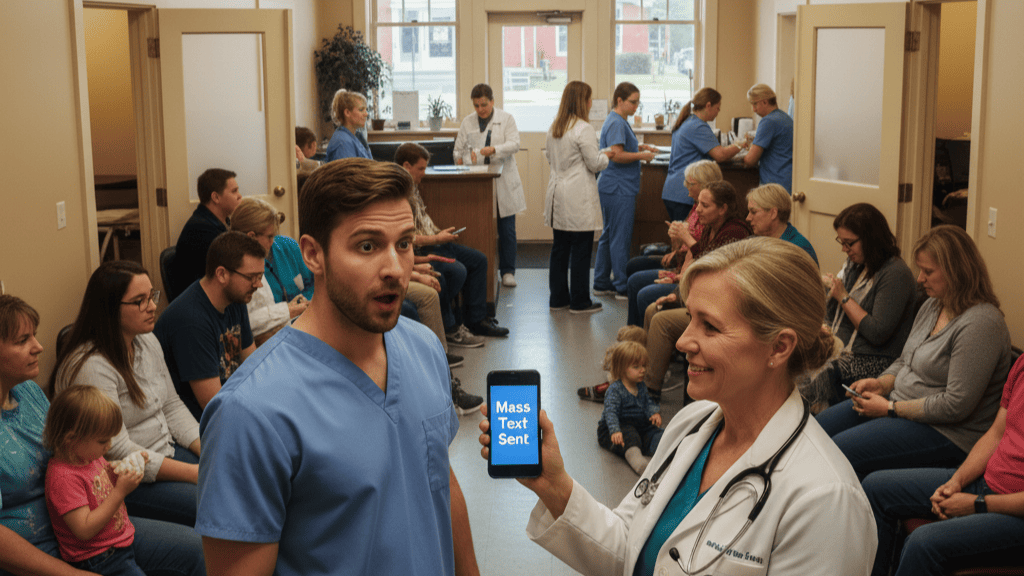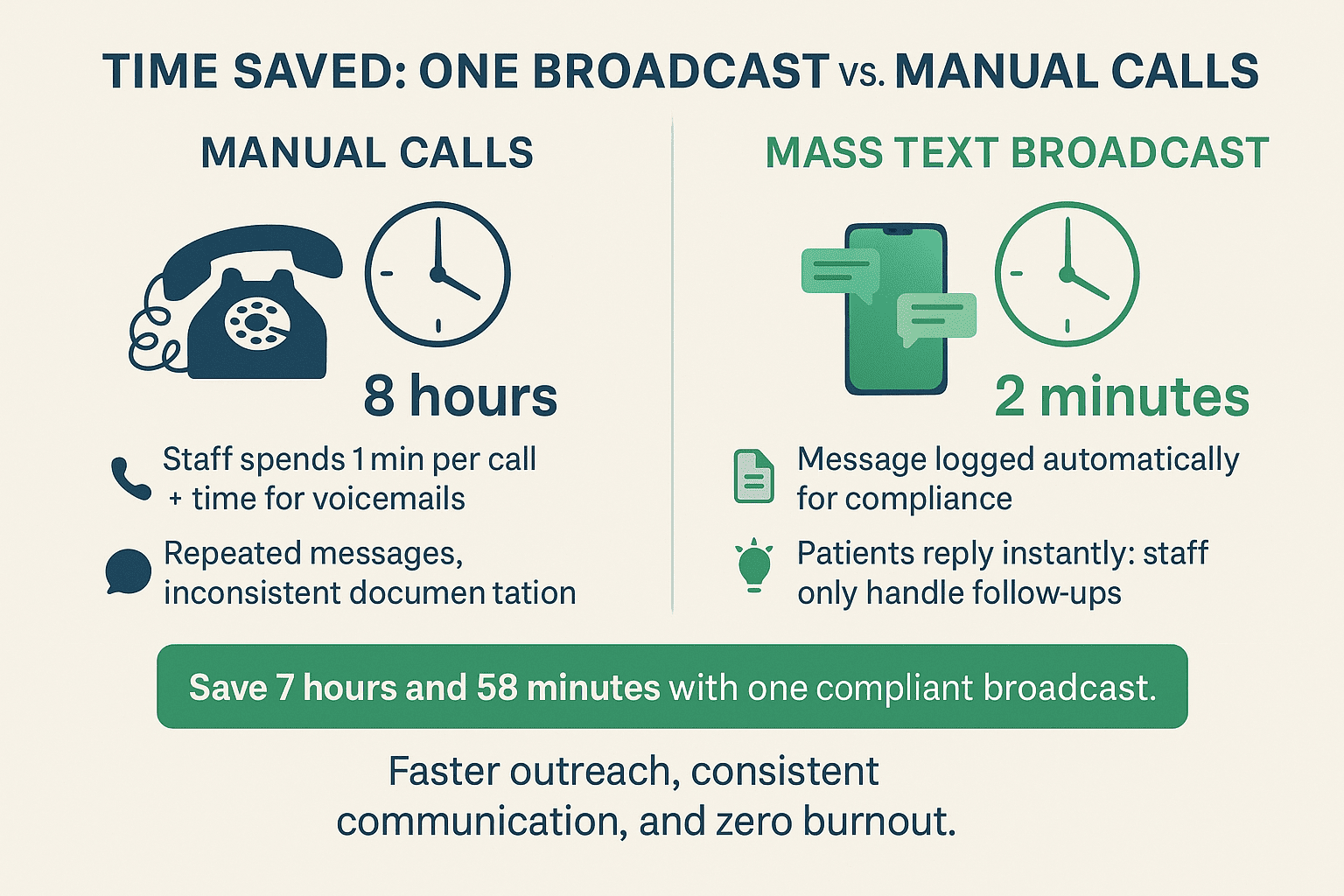Mass Texting in Cloud 9 Software with Curogram
💡 Mass texting in Cloud 9 Software changes how orthodontic and dental practices communicate. They're able to reach thousands of patients instantly...
8 min read
Gregory Vic Dela Cruz : Oct 30, 2025 4:17:49 PM

Launch HIPAA- and A2P-aligned broadcasts in minutes.
Use templates for preventive care, clinic updates, and recalls.
Target lists from your EMR for precise Office Ally patient outreach.
Send secure links for forms, directions, or education.
Track delivery, responses, and opt-outs for compliance.
Fill schedules for vaccines, screenings, and chronic care follow-ups.
Using a HIPAA-safe platform makes mass texting simple and secure, even if you're on a budget.
Small clinics need a real way to contact many patients at once without using too much time. Phone trees and one-by-one calls don’t scale, and emails are often ignored. If you're looking for a fast and reliable solution, then mass texting is the answer.
Mass texting solves the reach problem by meeting patients where they are—on their phones. using short, timely updates that spark action. When done with the right platform, broadcasts can be secure, compliant, and personalized.
In this article, we'll define broadcast messaging for budget-conscious clinics. We'll also and outline the limitations of manual outreach. You’ll see how bulk SMS quickly turns into saved hours and more preventive visits. We’ll also walk through real-world examples that prove why mass texting works.
If your team is stretched thin but still expected to keep patients engaged, this playbook is for you.
Budget-conscious clinics operate with thin staffing, fluctuating demand, and little time for manual outreach. Yet engagement expectations keep rising. Patients want timely updates about closures, new services, vaccine clinics, and eligibility for preventive care. The question is how to scale those messages without turning the front desk into a call center.
Mass texting directly addresses that problem. Instead of dialing lists one by one, staff can reach segmented groups in minutes—new patients, chronic-care cohorts, or patients due for screenings. Short, clear messages outperform email for immediacy and visibility, especially when they include a simple next step such as “Reply 1 to schedule” or a link to a self-serve form. Because mobile devices are always nearby, broadcasts get seen quickly and drive action the same day.
Manual outreach also creates uneven coverage: some patients get called, others don’t, and documentation is inconsistent. Broadcast messaging makes outreach predictable, repeatable, and measurable. Delivery status, responses, and opt-outs can be tracked at scale, giving administrators visibility into what worked and why. That data helps refine the next campaign and ensures compliance is documented without extra spreadsheets.
Finally, mass texting meets the moment for preventive and population health. Flu season, back-to-school requirements, chronic disease management, and screening reminders all benefit from concise, timely nudges. When clinics can broadcast to a well-defined list, they fill sessions, stabilize schedules, and reduce the scramble that leads to overtime and burnout. This is the heart of sustainable patient engagement for small practices: doing more with less while keeping quality and compliance intact.
In short, there’s a reason broadcasts have become a cornerstone of Office Ally patient outreach. They scale staff capacity, deliver information fast, and make it easier for patients to take the next step. For small teams navigating tight budgets and high expectations, mass texting is no longer a “nice to have”—it’s essential infrastructure for access and continuity of care.
Curogram adds a broadcast layer that aligns with privacy and carrier rules while staying simple for small teams. Staff choose a segment, select a template, personalize a few fields, and schedule or send. Messages can include secure links for directions, intake questions, or education, and responses flow into an inbox where staff can follow up one-to-one when needed. Everything is designed to be fast, traceable, and appropriate for healthcare messaging norms.
Compliance is built in. Campaigns follow A2P standards for consent, identity, and opt-out handling, and the platform supports HIPAA-aligned workflows for messages that reference patient information. Opt-out language is automatic, and delivery reporting helps clinics diagnose carrier filtering issues before they escalate. These controls allow broadcasts to reach hundreds of patients quickly without cutting corners on safeguards.
Templates make execution consistent. Clinics can load ready-to-use messages for vaccination days, screening recalls, holiday closures, inclement weather, and policy changes. Each template keeps the tone warm and clear, with a single call to action to reduce friction. Over time, performance analytics show which wording and timing generate the best results, so teams can iterate toward higher engagement.
Because Curogram connects with your EMR lists, outreach targets are precise. Staff can filter by location, provider, age band, condition registry, or last-visit date to keep messages relevant. That relevance reduces complaints and increases click-throughs and replies. For teams managing multiple locations or service lines, list-based targeting is the difference between noise and meaningful communication.
The bottom line: Curogram turns mass texting in Office Ally into a repeatable process. It respects consent, streamlines content, and gives your team the tools to measure outcomes. Broadcasts stop feeling risky or ad hoc and start operating like a dependable system that saves time and drives care.

Small practices adopt broadcast messaging for a simple reason: it works without adding complexity or cost. By integrating mass texting into Office Ally, small practices can manage becomes a daily habit—one that saves staff hours, improves experience, and increases visit volume. Below are the most consistent benefits clinics report after enabling Curogram-powered Office Ally campaigns.
Manual phone outreach doesn’t scale. A single broadcast replaces dozens or hundreds of calls, voicemails, and callbacks. Staff reclaim time for check-in, benefits verification, and in-office patient needs. Over a month, those reclaimed minutes add up to meaningful capacity.
Preventive care requires timely nudges. Broadcasts target patients due for vaccines, A1c checks, or cancer screenings with a few clear lines and a direct link. Because texts are seen fast, more patients act within 24–48 hours. Clinics fill calendars and reduce gaps in care.
Unexpected closures or policy updates create confusion. With a prepared template, clinics notify everyone affected in minutes and point to a simple next step. Staff no longer spend the morning returning voicemails to repeat the same message. Patients appreciate clarity, and frustration drops.
Short, relevant messages feel respectful of patients’ time. They provide just enough detail to act, often with a link for more information. When patients feel informed, trust grows—especially when communication is consistent during busy seasons. That trust shows up in reviews and retention.
Broadcasts generate delivery stats, responses, and opt-outs you can trend over time. That visibility lets you test send times, subject framing, and call-to-action wording. Teams keep what works and retire what doesn’t. Over a few cycles, engagement becomes predictably strong.
Nothing drains energy like an endless call queue. By moving routine updates to a broadcast, staff start the day with fewer fires and more focus. The shared inbox for replies spreads the load across the team. A calmer workday reduces turnover pressure and training costs.
Consent, identity, and opt-out rules are enforced automatically. Campaigns include required disclosures and capture outcomes for records. This reduces the risk of carrier filtering or regulatory complaints. Administrators can show that outreach followed policy without extra paperwork.
When a clinic can reach specific cohorts quickly—older adults for RSV shots, patients due for mammograms, or those with elevated A1c—it closes care gaps faster. Broadcasts become the backbone for preventive pushes and seasonal priorities. Over time, these nudges improve quality metrics. Better metrics support payer relationships and value-based performance.
Templates and approval flows keep tone and content aligned across sites. Patients hear one voice even if they visit different locations. Consistency builds confidence and reduces confusion. It also makes oversight easier for practice leadership.
Mass texting doesn’t require new hardware or long training. Teams start with a small set of templates and expand based on results. Because the workflow mirrors ordinary texting, adoption is quick. The impact appears immediately in saved time and faster patient responses.
Broadcast messaging is cost-effective compared with print and phone outreach. It drives measurable actions—clicks, replies, and booked visits—rather than impressions. Clinics can attribute outcomes to specific sends. That accountability helps prioritize campaigns with the highest return.
Once broadcasts are routine, clinics can layer in rules for timing, content variants, and follow-up based on responses. The combination of segmentation, templates, and analytics becomes a simple automation toolkit. Even small teams can run sophisticated outreach without custom IT projects. It’s a scalable path that grows with the practice.
Taken together, these benefits explain why broadcast messaging has become central to Office Ally patient outreach. It’s a practical, measurable way to keep patients informed and engaged, while giving staff time back for in-person care. With Curogram providing the rails for consent, deliverability, and tracking, clinics get the reach they need and the safeguards they require—without adding complexity.
Flu-season push: A small family practice prepared a segmented list of eligible patients and scheduled a two-message sequence for their Saturday shot clinic. The first broadcast announced the clinic and offered a quick-reply option to reserve a slot; the second confirmed directions and parking. Participation rose 22% versus the prior season, and same-day no-shows dropped because directions were clear. Staff reported fewer inbound calls and a smoother check-in window.
Instant closure notice: When a water main break forced a mid-morning closure, a clinic sent a broadcast to 900 patients with visits over the next two days. The message explained the issue, provided a link to reschedule, and promised a follow-up once service was restored. Most impacted patients rebooked within hours, and the team avoided a flood of voicemails. The next-day broadcast confirmed reopening, keeping the schedule intact.
Launching broadcasts is straightforward. Connect Curogram, verify your sending identity, and load a few templates for common scenarios—closures, vaccine days, and preventive recalls. Build your first lists from EMR criteria such as age, location, or last-visit date to keep outreach relevant. Send a small pilot to validate tone and timing, then scale to larger cohorts once you review delivery and response data.
As you grow, standardize a simple checklist: confirm the audience, confirm consent and opt-out language, confirm the call to action, and schedule the send. Assign one owner to approve content and another to monitor replies in the shared inbox. These lightweight guardrails keep broadcasts efficient and compliant. When you are ready, request a demo to review best practices and advanced targeting ideas tailored to your panel.
Curogram is built for small-practice realities: short staff, limited budgets, and the need to move fast without risk. It brings together list-based targeting, A2P-aligned consent handling, and clear opt-out controls in a workflow your team can run daily. Templates and delivery analytics make continuous improvement simple, and the shared inbox ensures any patient reply receives a fast, coordinated response.
Because it is healthcare-focused, Curogram supports HIPAA-aligned workflows for messages that may reference patient information. That matters when outreach shifts from general updates to secure follow-up. The platform keeps a full record of sends, deliveries, and opt-outs so administrators can demonstrate that outreach followed policy and carrier rules. In short, it gives clinics both the reach they want and the accountability they need.
If your goal is scalable Office Ally patient outreach that your team can own, Curogram provides the rails. It converts broadcasts from an occasional, stressful task into a reliable engine for updates, recalls, and preventive care campaigns. The payoff shows up in saved hours, steadier schedules, and patients who feel informed instead of surprised.
Broadcast messaging is the simplest way for small clinics to communicate at scale. With mass texting in Office Ally, you can reach the right cohort quickly. Your staff can handle replies in a shared inbox and capture outcomes for improvement.
When outreach is timely and relevant, patients respond. They show up for vaccine days and proactively reschedule when closures happen. Staff spend fewer hours on the phone and more time supporting in-person care. Leadership gains the visibility to fine-tune campaigns and prove compliance.
If you need a faster, more predictable way to implement mas texting, let Curogram help. Once you see how quickly patients engage, you’ll have a durable playbook that works for any campaign. And it's one that respects budgets and bandwidth while improving access to care.
Want to see how affordable mass texting works? Book a quick demo today.

💡 Mass texting in Cloud 9 Software changes how orthodontic and dental practices communicate. They're able to reach thousands of patients instantly...

💡 Mass texting in Allscripts PM helps enterprise groups reach patients quickly and consistently. Clinics use it for closures, policy changes,...

💡 Mass text messaging for Tebra helps clinics reach patients quickly. These clinics reduce no-shows and maintain HIPAA compliance with secure...